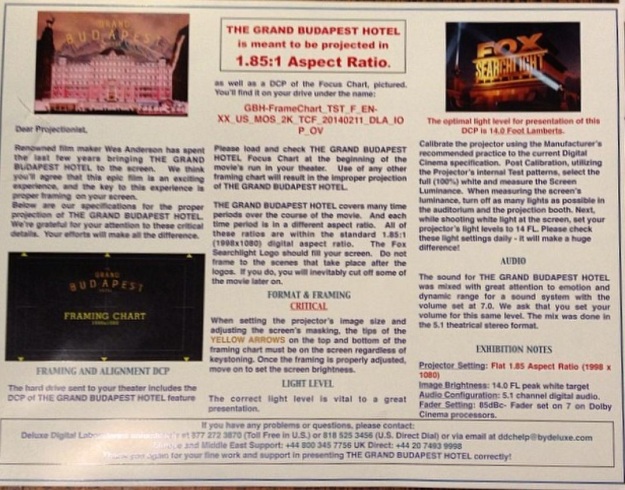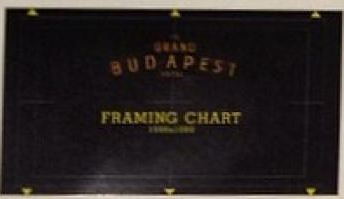When one thinks of a movie theater projectionist, the image of a young kid throwing a film reel on the projector before leaning back on his chair to play video games on his smartphone for the next two hours is probably something that comes to mind.

Okay, maybe not that young (or that intense), but regardless of age, when that projectionist shows up at work and finds out he has been tasked with running Wes Anderson’s new flick, “The Grand Budapest Hotel,” he should make sure to bring his A-game. You see, the following is a snapshot of the super technical instructions Deluxe Digital Laboratories sent out to theaters everywhere that instruct the projectionist on how to best display the film.

The image is a bit fuzzy, so let’s dive into what it actually says.
First and foremost, the big red box reads: “The Grand Budapest Hotel is meant to be project in 1.85:1 Aspect Ratio.” This is considered a common U.S. widescreen cinema standard, though a bit shorter than the current widescreen cinema standard ratio of 2.39:1 or 2.40:1. Either way, this is probably the simplist of the instructions.
Under “Framing and Alignment DCP”, the instructions read:
The hard drive sent to your theater includes the DCP of THE GRAND BUDAPEST HOTEL feature as well as a DCP of the Focus Chart, pictured. You’ll find it on your hard drive under the name: GBH-FrameChart_TST_F_EN-XX_US_MOS_2K_TCF_20140211_DLA_IOP_OV. Please load and check THE GRAND BUDAPEST HOTEL Focus Chart at the beginning of the movie’s run in your theater. Use of any other framing chart will result in the improper projection of THE GRAND BUDAPEST HOTEL.
Framing chart example below:

Simple. But now let’s get technical. As per the instructions:
THE GRAND BUDAPEST HOTEL covers many time periods over the course of the movie. And each time period is in a different aspect ratio. All of these ratios are within the standard 1.85:1 (1998×1080) digital aspect ratio. The Fox Searchlight Logo should fill your screen. Do not frame to the scenes that take place after the logos. If you do, you will inevitably cut off some of the movie later on.
In other words — don’t adjust the ratio, lest you ruin the film for everyone.
When it comes to formatting and framing, the studio instructs the projectionist to set the projector’s image size inside the tips of the yellow arrows of the framing chart (seen earlier). From there, the projectionist is to adjust the lighting:
“The optimal light level for presentation of this DCP is 14.0 Foot Lamberts” the instructions read in red font. There is then the following how-to guide:
Calibrate the projector using the Manufacturer’s recommended practice to the current Digital Cinema specification. Post Calibration, utilizing the Projector’s Internal Test patterns, select the full (100%) white and measure the Screen Luminance. When measuring the screen’s luminance, turn off as many lights as possible in the auditorium and the projection booth. Next, while shooting white light at the screen, set your projector’s light levels to 14FL. Please check these light settings daily – it will make a huge difference!
Lastly, when it comes to audio, the instructions beseech the projectionist to do right by the film, and match the volume of the sound system with which the film was constructed:
The sound for THE GRAND BUDAPEST HOTEL was mixed with great attention to emotion and dynamic range for a sound system with the volume set at 7.0. We ask that you set your volume for this same level. The mix was done in the 5.1 theatrical stereo format.
So much for just throwing on the reel, lowering the light, and pressing play.
The film, with its all-star cast, including the likes of Ralph Fiennes, Bill Murray, Tilda Swinton, Edward Norton, Harvey Keitel, and more (seriously, check out the full roster) is expected to be a box office hit (it already broke the record of highest-grossing limited live action debut of all time). That said, there’s a good chance that some of the readers browsing through this article have seen already seen “The Grand Budapest Hotel.” Rather than get your critical opinion of the film itself, tell us—was it presented in its proper format? Or did you happen to notice a few technical glitches along the way that may have been due to the projectionist not following some of the aforementioned instructions.
Comment in the section below!
Advertisement
Learn more about Electronic Products Magazine





